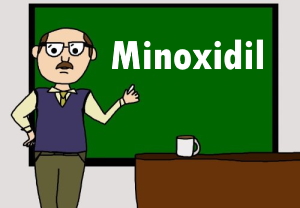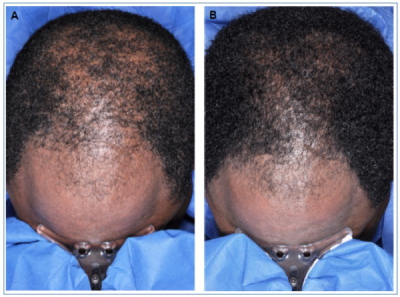Last Updated on September 8, 2020 by Robert Price
Minoxidil, AKA old faithful. It’s been helping guys avoid premature baldness since the dawn of man — or 1988 to be exact.
That’s almost prehistoric by hair loss treatment standards.
My dad’s using minoxidil right now. It’s working for him. Minoxidil’s been around so long, it may well have helped my horseshoe-bald grandpa avoid his fate too.
But this post isn’t about him, it’s about you.
Can minoxidil help you win your hair loss battle? The short answer is yes, it probably can.
Look, minoxidil gets a bad wrap sometimes, but that’s primarily because people are morons.
The cycle of idiocy often plays out like this: Someone stops using minoxidil as instructed, they lose the hair they regrew with the product, and then they throw a fit on social media and leave negative product reviews.
In this post, I’ll review the facts about minoxidil, citing statistics and studies from reputable sources. I’ll also go over the side effects, best products, FAQs, everyday use instructions, and more.

Let’s start the class. I’ll keep this pithy and educational. If you look like the professor here, stop reading now. It’s too late for you, sorry. The rest of you, please continue.
How Minoxidil Works
Minoxidil works by increasing blood flow to the scalp and hair follicles. It can prolong the hair growth cycle and promote regrowth in both men and women.
Originally used as a heart medication, minoxidil’s effectiveness as a hair loss remedy was discovered by accident. During clinical trials, researchers found that it not only reduced blood pressure in patients, it also regrew their hair!
Naturally, the good folks at Johnson & Johnson wanted to cash in on this discovery. Rogaine was born shortly thereafter. Old faithful. The hair loss medication that’s helped multiple generations of men enjoy thick, healthy, silver hair into their golden years.
The Studies – How Effective is Minoxidil?
In 2012, a one-year observational study on minoxidil was conducted.
984 patients suffering from male pattern hair loss participated. They applied the 5% minoxidil formula twice daily. Every three months, they sent the hairs they lost during a hair washing to a laboratory for counting. Dermatologists also evaluated the hair loss of each participant at the beginning and the end of the study. They found:
- Hair loss areas became smaller in 62% of the patients, unchanged in 35.1% of the patients, and larger in 2.9%.
- The 5% minoxidil product was deemed very effective in 15.9% of participants, effective in 47.8%, moderately effective in 20.6% and ineffective in 15.7. That’s about an 84% success rate.
- Side effects were observed in 3.9% of patients, none of which were classified as serious.
- The number of hairs shed when washed decreased from a mean of 69.7 at the beginning of the study to 33.8 at the conclusion of it.

Favorable responder. Taken from this short, 8-week minoxidil study.
The longest minoxidil study I’m aware of was completed in 1990 and published by the Journal of American Academy of Dermatology.
There were 31 participants, all of whom used 2 and 3% topical minoxidil formulations. The study was conducted over 4.5-5 years. It concluded that while regrowth tended to plateau after a year, minoxidil remained effective in helping the majority of patients maintain their hair growth throughout the duration of the 5-year study.
Minoxidil has also been shown to provide regrowth in up to 60% of women.
What Dermatologists and Hair Loss Specialists Think About Minoxidil
Opinions are mixed on minoxidil. It’s prescribed often, though. Propecia or finasteride is typically the preferred, first-line treatment option for men, especially among hair loss specialists and organizations.
The American Hair Loss Association, for example, does not recommend minoxidil as “the first line of attack for men suffering with male pattern baldness.” They recommend Propecia. They do say that minoxidil may be an effective supplementary option, and that it can be used as a treatment alternative for those who cannot tolerate Propecia.
Common Minoxidil FAQs
What’s Better, Minoxidil or Finasteride?
Nobody contests the fact that finasteride is a more effective hair loss treatment than minoxidil. That said, finasteride/Propecia has been linked to long-term sexual side effects in a small percentage of its users. So it’s not surprising that many young men don’t want to take Propecia, at least not without trying alternative treatments first, such as minoxidil.
Should I take 2% or 5% Minoxidil?
The 5% solution is more effective for men. Women are generally more sensitive to minoxidil, and they are often advised to take the 2% formula. Doctors do recommend 5% minoxidil to women, as well; it typically yields better results, but in women the 5% formula is known to cause more skin-related side effects.
What’s Better, the Foam Or the Liquid formula?
It depends who you ask. But some experts and studies have found that the scalp absorbs the liquid formula more effectively than the foam. However, the liquid is also known to cause more itching and skin irritation than the foam. Some patients also complain that the liquid minoxidil is too greasy.
The International Society of Hair Restoration Surgeons is an industry-leading organization, comprised of hair loss surgeons and specialists. In their 2015 survey, the results were about even among their members: 59.5% of the respondents recommended Rogaine foam often or always to their patients. 56.2% either always or often recommended the liquid.
So it’s about an even split by my estimation. It could be worth trying out both and seeing which one you like better.
For more details, check out my article comparing minoxidil foam to the liquid, based on price, convenience, effectiveness, and 3 other factors.
Should I Apply Minoxidil Once or Twice Per Day?
The answer to this question will also vary. In most cases, men are advised to apply the 5% minoxidil solution twice per day. But many doctors have found that patients don’t comply with this recommendation, and say that applying minoxidil once daily is adequate.
Dr. Robert Bernstein, a prominent hair restoration surgeon and the co-author of Hair Loss for Dummies, tells his patients that using minoxidil once per day around bedtime is sufficient, as long as they apply at least twice the recommended dosage to the thinning areas. Women can either apply the 2% solution twice per day, or use the 5% solution once.
How Long Until I see Results?
If you respond to the medication, you should start seeing results in 4-6 months. Your success will be contingent on many factors, including your degree of hair loss, expectations, and how well you comply with the treatment guidelines. You will likely experience a “shed” before you notice any positive results. In other words, things may get worse before they get better. That’s normal, it means the medication is working. More on this later.
How Long Do I Need to Take It For?
This is minoxidil’s biggest downside. You must keep taking it indefinitely in order to maintain your results. But contrary to what some ignoramuses say online, it won’t make you go bald! But if you stop taking it, you’ll probably lose any progress you made within a year or so, possibly less.
Minoxidil Side Effects
Minoxidil is well-tolerated by most patients. The most common side effects are dermatological, including skin irritation, redness, dryness, flaking, and scalp inflammation. 3.9% of patients experienced side effects in the 2012, 984-participant study on minoxidil — and again, none of those effects were deemed as serious.
Absorptive Side Effects
When minoxidil is absorbed through the skin into the bloodstream, more serious side effects can occur. They include dizziness, chest pain, swelling of the hands or feet, fainting, difficulty breathing, low blood pressure, and gastrointestinal issues. A small number of patients have also reported irregular heartbeats and other similar issues (source).
But here’s the good news: according to the American Hair Loss Association, “the amount of minoxidil absorbed in the bloodstream is usually too small to cause internal side effects” (source). Still, if you notice any side effects, especially of the severe variety, be sure to contact your doctor or emergency services immediately.
How to Avoid the Abortive Effects
Don’t apply too much and follow the instructions; that will help you avoid the internal side effects more than anything else.
Best Minoxidil Products
Rogaine is still the #1 dermatologist-recommended minoxidil product. There are countless generic minoxidil formulas available as well. The Kirkland brand minoxidil has an excellent reputation by and large — and you can often purchase a six-month supply for around $25. Comparatively, Rogaine will set you back around $80 for a six-month supply.
Supplementary Treatments
Minoxidil can be used in conjunction with most other hair loss treatments. But check with your doctor first. It’s most frequently combined with Propecia, and when these medications are used together, patients often achieve outstanding results over long periods of time.
Some patients prefer to use natural alternatives to Propecia, which don’t work as well but have less side effects. Saw palmetto and pumpkin seed oil are perhaps the two most popular, natural, DHT-lowering supplements available for men’s hair loss.
DHT, of course, is the hormone that causes androgenic alopecia or male pattern baldness. Women can use DHT-lowering supplements too, though they’re typically not recommended for women who are pregnant or nursing. Viviscal is another possibility; it’s the #1 hair health supplement on the market, primarily marketed to women, but studies have shown that it’s effective for men, too.
If you’re determined to defeat your hair loss, no matter the cost, PRP and laser therapy are two more promising but relatively new options you could contemplate adding to your treatment arsenal.
Rosemary oil is perhaps the best natural alternative to minoxidil — though it’s untested as long-term treatment and unlikely to be as effective minoxidil.
6 Minoxidil Benefits
- Proven – It’s been tested, it works, and it helps a significant percentage of men (and women) maintain and/or regrow hair.
- FDA Approved – Along with finasteride, minoxidil is the only treatment for hair loss that has been through the FDA’s rigorous approval process.
- 25+ Year Track Record – It’s literally helped generations of balding men retain their hair.
- Affordable – Minoxidil products are available for as little as a few dollars per month. You get a lot of bang for your buck.
- Doctor Approved – It’s probably the most widely recommended hair loss treatment. Period.
- Minimal Side Effects – Minoxidil is very well-tolerated with few exceptions; side effects are typically limited to skin irritation and other dermatological issues.
The 4 Biggest Negatives
- Must be Taken Indefinitely – You have to use it consistently, indefinitely, otherwise your hair will start falling out again; and worse, you’ll also lose the hairs you kept or regrew as a result of the treatment.
- The Chemicals & History – The fact that minoxidil was originally formulated from a blood-pressure medication is a turn-off for some patients. Many people also cite concerns with the rare, absorptive side effects, which can lead to heart and gastrointestinal problems. Again, such side effects are extremely uncommon based on everything I’ve read — but still, this is an issue for some patients.
- You May Experience a “Shed” – As your hair follicles are revitalized by the minoxidil, some of your weak and thinning hairs may shed. That’s a sign the treatment is working. It shouldn’t last more than a month or two. Some guys stop taking minoxidil when they notice shedding, which is the absolute worst thing you can do! Suffer through the shed, it will be worth it.
- Positive Effects will Diminish Over Time – Minoxidil extends the growing phase of the hair growth cycle. It doesn’t stop the balding process completely. Many men have reported positive results with minoxidil over the course of decades, but its effectiveness will wane over time.
Minoxidil Vs. Mother Nature – The Verdict
There’s a good chance minoxidil can help you fight a long, successful battle against hair loss. Will it enable you to keep all your hair forever? Probably not. But if you combine minoxidil with other therapies like Propecia, laser therapy, saw palmetto, or PRP, your odds of success can increase dramatically. Hair transplantation is another option — and good hair transplants, while expensive, are usually undetectable and considered very safe.
If you have any questions about minoxidil or you would like share your minoxidil experience, leave a comment in the comment section below.
Related Minoxidil Reading:
- The 8 Biggest Minoxidil Mistakes That Can Lead to Baldness!
- Foam vs. Liquid Minoxidil – And the Winner Is…
- Minoxidil Shedding – 7 Things You Should Know about the “Dread Shed”
- Finasteride, Minoxidil or Both? 6 Factors to Consider Before You Start Treatment
- 10 Fast Facts About 10% Minoxidil
Robert Price is a writer, consumer advocate, and hair loss researcher with thousands of hours of experience in the field. His goal is to keep you out of the hair loss rabbit hole, underworld, or whatever you want to call it. He founded Hair Loss Daily, the unbiased hair loss blog, in 2016. You can learn more about Robert in the my story section of this website.




